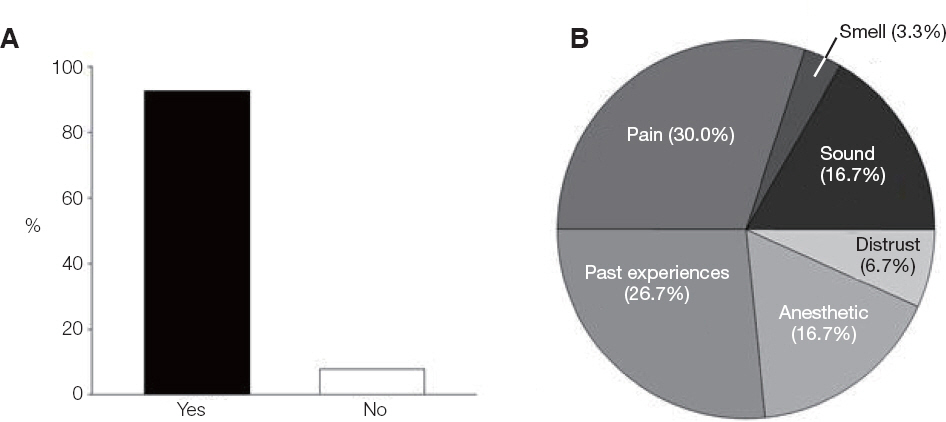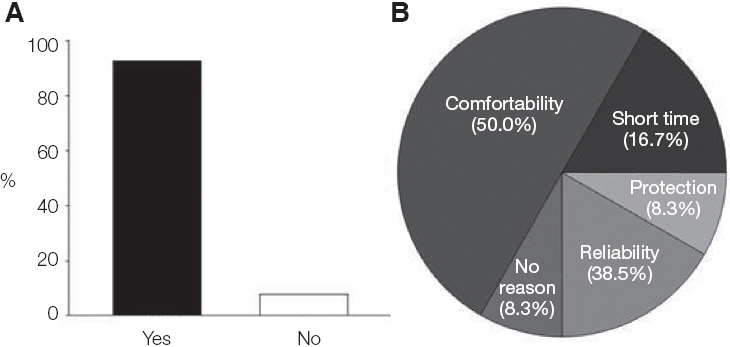J Dent Rehabil Appl Sci.
2018 Dec;34(4):270-279. 10.14368/jdras.2018.34.4.270.
Questionnaire survey for the clinical trial participants who experienced both digital and conventional impression
- Affiliations
-
- 1Department of Prosthodontics and Dental Research Institute, School of Dentistry, Seoul National University, Seoul, Republic of Korea. limdds@snu.ac.kr
- 2Dental Life Science Research Institute & Clinical Translational Research Center for Dental Science, Seoul National University Dental Hospital, Seoul, Republic of Korea.
- 3Department of Oral Anatomy, School of Dentistry, Seoul National University, Seoul, Republic of Korea.
- KMID: 2432363
- DOI: http://doi.org/10.14368/jdras.2018.34.4.270
Abstract
- PURPOSE
The aim of this study was to assess the patients' perception, acceptance, and preference of the difference between a conventional impression and digital impression through questionnaire survey.
MATERIALS AND METHODS
Thirteen (6 male, 7 female) subjects who experienced both digital and conventional impression at the same day were enrolled in this study. Conventional impression were taken with polyvinylsiloxane and digital impression were performed using a newly developed intra-oral scanner. Immediately after the two impressions were made, a survey was conducted with the standardized questionnaires consisting of the following three categories; 1) general dental treatment 2) satisfaction of conventional impression 3) satisfaction of digital impression. The perceived source of satisfaction was evaluated using Likert scale. The distribution of the answers was assessed by percentages and statistical analyses were performed with the paired t-test, and P < 0.05 was considered significant.
RESULTS
There were significant differences of the overall satisfaction between two impression methods (P < 0.05). Digital impression showed high satisfaction in less shortness of breath and odor to participants compared to conventional impression. The use of an oral scanner resulted in a discomfort of TMJ due to prolonged mouth opening and in lower score of the scanner tip size.
CONCLUSION
It was confirmed that the preference for the digital impression using intraoral scanner is higher than the conventional impression. Most survey participants said they would recommend the digital impression to others and said they preferred it for future prosthetic treatment.
Keyword
Figure
Reference
-
References
1. Morey EF. Dimensional accuracy of small gold alloy castings. Part 1. A brief history and the behaviour of inlay waxes. Aust Dent J. 1991; 36:302–9. DOI: 10.1111/j.1834-7819.1991.tb00727.x. PMID: 1789765.2. Barbosa GA, Simamoto Júnior PC, Fernandes Neto AJ, de Mattos Mda G, Neves FD. Prosthetic laboratory influence on the vertical misfit at the implant/UCLA abutment interface. Braz Dent J. 2007; 18:139–43. DOI: 10.1590/S0103-64402007000200010. PMID: 17982554.3. Beuer F, Schweiger J, Edelhoff D. Digital dentistry: an overview of recent developments for CAD/CAM generated restorations. Br Dent J. 2008; 204:505–11. DOI: 10.1038/sj.bdj.2008.350. PMID: 18469768.4. Davidowitz G, Kotick PG. The use of CAD/CAM in dentistry. Dent Clin North Am. 2011; 55:559–70. DOI: 10.1016/j.cden.2011.02.011. PMID: 21726690.5. Prudente MS, Davi LR, Nabbout KO, Prado CJ, Pereira LM, Zancopé K, Neves FD. Influence of scanner, powder application, and adjustments on CAD-CAM crown misfit. J Prosthet Dent. 2018; 119:377–83. DOI: 10.1016/j.prosdent.2017.03.024. PMID: 28689912.6. Takeuchi Y, Koizumi H, Furuchi M, Sato Y, Ohkubo C, Matsumura H. Use of digital impression systems with intraoral scanners for fabricating restorations and fixed dental prostheses. J Oral Sci. 2018; 60:1–7. DOI: 10.2334/josnusd.17-0444. PMID: 29576569.7. Seelbach P, Brueckel C, Wöstmann B. Accuracy of digital and conventional impression techniques and workflow. Clin Oral Investig. 2013; 17:1759–64. DOI: 10.1007/s00784-012-0864-4. PMID: 23086333.8. Zhang F, Suh KJ, Lee KM. Validity of Intraoral Scans Compared with Plaster Models: An In-Vivo Comparison of Dental Measurements and 3D Surface Analysis. PLoS One. 2016; 11:e0157713. DOI: 10.1371/journal.pone.0157713. PMID: 27304976. PMCID: PMC4909173.9. Kim KM. Likert scale. Korean J Fam Med. 2011; 32:1–2. DOI: 10.4082/kjfm.2011.32.1.1.10. Yuzbasioglu E, Kurt H, Turunc R, Bilir H. Comparison of digital and conventional impression techniques: evaluation of patients' perception, treatment comfort, effectiveness and clinical outcomes. BMC Oral Health. 2014; 14:10. DOI: 10.1186/1472-6831-14-10. PMID: 24479892. PMCID: PMC3913616.11. Lee SJ, Macarthur RX 4th, Gallucci GO. An evaluation of student and clinician perception of digital and conventional implant impressions. J Prosthet Dent. 2013; 110:420–3. DOI: 10.1016/j.prosdent.2013.06.012. PMID: 23998623.12. Joda T, Lenherr P, Dedem P, Kovaltschuk I, Bragger U, Zitzmann NU. Time efficiency, difficulty, and operator's preference comparing digital and conventional implant impressions: a randomized controlled trial. Clin Oral Implants Res. 2017; 28:1318–23. DOI: 10.1111/clr.12982. PMID: 27596805.13. Schepke U, Meijer HJ, Kerdijk W, Cune MS. Digital versus analog complete-arch impressions for singleunit premolar implant crowns: Operating time and patient preference. J Prosthet Dent. 2015; 114:403–6. DOI: 10.1016/j.prosdent.2015.04.003. PMID: 26047800.14. Benic GI, Mühlemann S, Fehmer V, Hämmerle CH, Sailer I. Randomized controlled within-subject evaluation of digital and conventional workflows for the fabrication of lithium disilicate single crowns. Part I: digital versus conventional unilateral impressions. J Prosthet Dent. 2016; 116:777–82. DOI: 10.1016/j.prosdent.2016.05.007. PMID: 27460321.15. Wismeijer D, Mans R, van Genuchten M, Reijers HA. Patients' preferences when comparing analogue implant impressions using a polyether impression material versus digital impressions (Intraoral Scan) of dental implants. Clin Oral Implants Res. 2014; 25:1113–8. DOI: 10.1111/clr.12234. PMID: 23941118.
- Full Text Links
- Actions
-
Cited
- CITED
-
- Close
- Share
- Similar articles
-
- Comparison of patient satisfaction with digital and conventional impression for prosthodontic treatment
- Comparison of the fit of cast gold crowns fabricated from the digital and the conventional impression techniques
- Digital intraoral impression for immediate provisional restoration of maxillary single implant: A case report
- Conventional and digital impressions for complete-arch implant-supported fixed prostheses: time, implant quantity effect and patient satisfaction
- Comparison of accuracy between digital and conventional implant impressions: two and three dimensional evaluations





